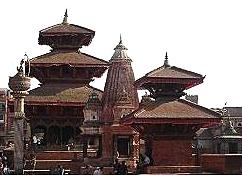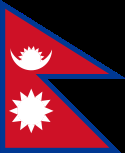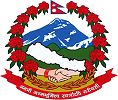Particulars:
- Official Language: Nepali, but English is widely spoken
- Area total: 1543 Ha
- Latitude/ Longitude:
27° 40' 45.25 " N, 85 ° 19' 37.23" E
- Altitude: 1310 m
- Calling codes: Nepal country code: 977, City code: 1
- Time Zone:
NPT (UTC+5:45)
- Currency: Nepali Rupee (NRS)
- Climate:
Dry season: October - May; Wet (Monsoon) season: June - September.
- Temperature Ranges:
Spring: 16-23 deg C
Summer: 19 - 27 deg C
Fall: 15 - 24 deg C
Winter:
2 - 20 deg C
- Tourist visa required to enter Nepal; available from entry points such as airports.
-Electricity: 220 V
|
|
|
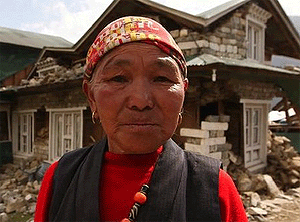 *******
Patan.com and Basecamp International continue to mourn the
tragic loss of lives, property, and culture in the Khatmandu
region, due to the 7.9 devastating earthquake that occured
there on April 25th, 2015. ******* *******
Patan.com and Basecamp International continue to mourn the
tragic loss of lives, property, and culture in the Khatmandu
region, due to the 7.9 devastating earthquake that occured
there on April 25th, 2015. *******
Some up to date news, stories, and facts about this historical and
tragic event can be accessed at the following links:
*
BBC News - May 2nd - "Nepal quake: "No Chance" to
find more survivors, as death toll rises.
*
WIKILEAKS page - 2015 Nepal earthquake.
*
The Guardian - Nepal earthquake: CCTV from Kathmandu captures building
collapse- video.
*
Time - These are the 5 facts that explain Nepal's devastating earthquake.
*
CNN - Emergency on helicopter as Nepal quake victim stops breathing.
For those with the resources and willingness to do so, you can DONATE
TO THE RED CROSS now, with its current relief efforts for Nepal,
here.
Some other worthy organization's earthquake relief efforts, (among
many), include: AID
NEPAL, and UNICEF.ORG.
Please do what you can to help.
As time progresses and the affected Nepalese cities and regions rebuild,
we will update this website to the best of our ability. |
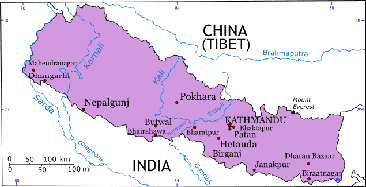
Introduction to Patan:
Located about 5 km south of Kathmandu in the Kathmandu Valley, on the southern side of the Bagmati River, Patan is one of 3 royal cities in the valley. The others are Kathmandu and Bhaktapur.
A destination for connoisseurs of fine arts, Patan is filled with wood and stone carvings, metal statues, ornate architecture, including dozens of Buddhist and Hindu temples, and over 1200 monuments.
The city is known for its rich tradition of arts and handicrafts and as the birthplace of master craftsmen and artists such as Arniko and Kuber Singh Shakya.
To get a great idea of the daily life of people living in Patan, check
out this terrific short film made by a traveler/ film maker
named Alexander
Rose,
after spending 6 months in Patan.
Patan.com thanks Alexander for his work and for allowing us to link his
great film from this website!
Watch the film and let him know how you feel about it.
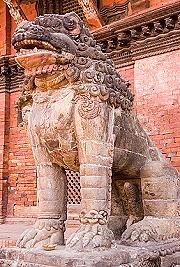 Trivia & Quick Points: Trivia & Quick Points:
-
The official name of the city is "Lalitpur" (City of Beauty).
-
This city is located in the district also called Lalitpur.
-
The city is comprised of 22 municipal wards.
-
Patan's population (as of 2006) is close to 200,000.
-
Patan is the third largest city in Nepal.
-
The economy of Patan is based on trade and commerce, tourism, art, handicrafts, and agriculture
-
The water supply in Kathmandu Valley is currently insufficient in both quality and quantity. Tourists should not drink untreated water.
-
Outbreaks of cholera and malaria occur from time to time. Tourists may want to get vaccinations for hepatitis A and B, meningitis, polio, and typhoid before visiting Patan.
Facts & Information:
History:
The city of Patan is believed to have been built in the third century B.C. by the Kirat dynasty. It was expanded by Lichhavis in the 6th century A.D. and again by the Mallas in medieval period. The Malla kings ruled the Kathmandu Valley until the ascension of the Shah dynasty. In 1768, King Prithvi Narayan Shah began his campaign to unify Nepal and Patan became a city in the kingdom of Nepal.
In the early 1800's the Shah heirs fought the Anglo-Nepalese War (1814-1816) against the British East India Company over the annexation of small neighboring states. The Nepalese lost and were forced to cede land to the British in exchange for autonomy.
In 1846, Queen Rajendralakshmi sought to curb the power of the military leader, Jang Bahadur. An armed clash between the queen's loyalists and the miliary personnel loyal to Bahadur ensued in the palace armory in Kathmandu, after which the queen had several hundred prominent men executed, including princes and chieftans. This became known as the Kot Massacre. Badahur emerged from the fighting as the only powerful leader and took the office of Prime Minister. He made the prime minister position autocratic and hereditary. During his reign he purged his enemies by killing and driving thousands into exile, including the king and queen. He replaced them with a figurehead monarch, who gave Bahadur the title 'Rana'. The rule of Bahadur and his heirs over the next 100 years became known as the Rana dynasty.
The dynasty was brought down in the 1950's by reformists who instituted a consitutional monarchy. 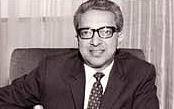 This lasted until 1962, when King Mahendra created a panchayat system of government. This system created a pyramid structure of power based on councils from the village level to the National Parliament, with the King as head of state. This lasted until 1962, when King Mahendra created a panchayat system of government. This system created a pyramid structure of power based on councils from the village level to the National Parliament, with the King as head of state.
King Mahendra's son, King Birendra ascended the throne in 1972 and promised democratic reforms. He called a national referendum in 1980 to decide whether to continue the panchayat system, with reforms, or to establish a multi-party system of government. The panchayat system won a close victory.
The 1990 People's Movement ('Jana Andolan') was a cooperative effort among political parties of Nepal, including the Nepali Congress and Communist parties, to establish a constitutional democracy. It ended the panchayat system, and resulted in Nepal's first election in almost 50 years, in 1991. The following year, as a result of economic crises, a leftist group called the Joint People's Agitation Committee called for a general strike. Violence ensued, and clashes in Patan between police and activists resulted in the deaths of two activists. In Kathmandu, a crowd rallying at Tundikhel was attacked by police, resulting in an estimated 14 more deaths.
In 1995, in response to corruption, the Communist Party of Nepal (the Maoists) declared a People's war. They called for the redistribution of land, increased power for rural communities, the elimination of the caste system, equal rights for women, and the creation of a communist republic.
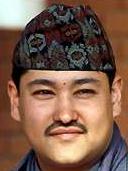 In 2001, Crown Prince Dipendra assassinated 11 members of the royal family, including the king and queen, and was declared King. However, he died days later of a self-inflicted gunshot wound. The brother of the assassinated King Birendra, Prince Gyanendra, ascended the throne. In 2001, Crown Prince Dipendra assassinated 11 members of the royal family, including the king and queen, and was declared King. However, he died days later of a self-inflicted gunshot wound. The brother of the assassinated King Birendra, Prince Gyanendra, ascended the throne.
In 2002, due to the escalation of the Maoist rebellion, the king took control of the government temporarily and then appointed a new government. After a Maoist siege on the Kathmandu Valley in 2004, the king declared a state of emergency and assumed full authoritarian power. The king controlled the media and placed politicians under arrest.
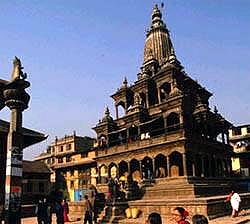 In April, 2006, as a result of protests and strikes, the king reinstated parliament. The parliament then stripped the king of most of his powers. The Maoists reached a cease-fire agreement with the government in 2006, and then took a quarter of the seats in the newly elected parliament in January, 2007. In April, 2007, five Maoist ministers were sworn in and placed in charge of the ministries of information, local development, planning and works, forestry, and women and children. Scattered conflicts continue across the country, however. In April, 2006, as a result of protests and strikes, the king reinstated parliament. The parliament then stripped the king of most of his powers. The Maoists reached a cease-fire agreement with the government in 2006, and then took a quarter of the seats in the newly elected parliament in January, 2007. In April, 2007, five Maoist ministers were sworn in and placed in charge of the ministries of information, local development, planning and works, forestry, and women and children. Scattered conflicts continue across the country, however.
Culture
Patan is a center of Buddhist and Hindu culture. The city is full of religious art, temples, and monasteries. Many religious festivals take place in Patan each year. One is the Buddha Jayanti festival, marking the birthday of Lord Buddha, which occurs on Jestha Purnima (full moon night in April or May).
The birthday of Lord Krishna is celebrated by Hindus at the Krishna Temple in Patan in August - September. Devotees gather at the Krishna Temple in Patan Durbar Square for a vigil through the night. The following day, the devotees visit all the Krishna shrines throughout the city.
The largest festival in Nepal is the Dashain festival in September to October. This festival takes place at the Palace Complex in Patan as well as in the other cities of the Kathmandu Valley and commemorates a victory by the gods over wicked demons. The celebration lasts 15 days and includes kite flying.
Travel & Tourism:
The city of Patan offers visitors the chance to see an abundance of exquisite works of religious art and architecture. In addition, adventurous travelers can find many opportunities for trekking, mountain biking, whitewater rafting, aerial exploration of the Kathmandu Valley, and mountaineering. Many tours can be arranged from Kathmandu, just a few kilometers away.
Highlights & Features of the City and Surroundings:
-
The four Ashoka Stupas,  marking the four corners of Patan, are symbolic of the Buddhist Wheel of Righteousness ('Dharma-Chakra'). Located at Pulchowk, Lagankhel, Ebahi and in Teta, t hese mounds are crowned with monuments that the Buddhist Emperor of India, Ashoka, is said to have erected in 250 B.C. Each stupa is different. Three of the mounds are covered in grass, whereas the fourth is a white mound with a colorful monument atop. marking the four corners of Patan, are symbolic of the Buddhist Wheel of Righteousness ('Dharma-Chakra'). Located at Pulchowk, Lagankhel, Ebahi and in Teta, t hese mounds are crowned with monuments that the Buddhist Emperor of India, Ashoka, is said to have erected in 250 B.C. Each stupa is different. Three of the mounds are covered in grass, whereas the fourth is a white mound with a colorful monument atop.
-
In the heart of Patan and the Patan marketplace, Patan Durbar Square is filled with ancient palaces, pagoda temples, stone baths, Hindu and Buddhist statues, bas relief and engravings, and bronze carvings.
-
The Palace of the Malla Kings is one of the highlights of a visit to Patan. In the palace complex lies the stone temple of Lord Krishna ('Krishna Mandur') with its 21 spires and bas-relief art depicting scenes from the Mahabharata and Ramayana epics. The temple was built by King Siddhi Narasingha Malla in the 16th century A.D. The Royal Bath (known as 'Tushahity') is another showpiece of fine stone and bronze carving in the palace complex.
Patan Durbar Square is one of seven monument zones in the Kathmandu Valley that together have been designated a UNESCO World Heritage Site. Also located in the square is the Patan Museum, which houses bronze statues and religious objects, some dating back to the 11th century. This museum, which was originally a Malla palace, is open daily.
What to Do & See
-
The 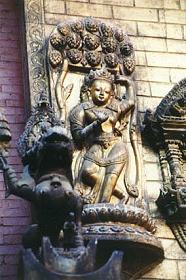 Golden Temple (Hiranya Varna Mahavihar), built in the 12th Century by King Bhaskar Verma, is located just north of Durbar square. This three-roof Buddhist monastery is adorned with a golden facade, four large gateways, a clock tower, and two lion sculptures. Inside are golden images of Buddha, wall carvings, and a prayer wheel. Golden Temple (Hiranya Varna Mahavihar), built in the 12th Century by King Bhaskar Verma, is located just north of Durbar square. This three-roof Buddhist monastery is adorned with a golden facade, four large gateways, a clock tower, and two lion sculptures. Inside are golden images of Buddha, wall carvings, and a prayer wheel.
-
Just outside the Patan marketplace, the Rato (Red) Machhindranath Temple is dedicated to the god of rain and plenty. It has four doorways with intricate carvings, each with figures of lions, and statues of a variety of animals atop its pilars. Set into the base of the temple are prayer wheels. This temple is the site of the Rato Machhindranath celebrations, which include a parade with a temple chariot and end in a nearby village called Bungamati. This festival takes place during April and May every twelfth year.
-
Rudra Varna Mahavihar is a Buddhist monastery with a temple and a courtyard that has many fine wood, bronze and stone statues. Kings were crowned in this temple in ancient times.
-
The Patan Industrial Estate, located at Lagankhel (near Sat Dobato) in Pata is a destination for tourists interested in purchasing fine art and handicrafts from local artisans. Handicrafts such as wood carvings, metalwork, carpets, and paintings are available here.
-
The Kumbheshwor Temple is one of only two 5 tiered temples in Nepal. Dating back to 1391, when it was built by JayastHiti Malla with two tiers, it hosts an annual pilgrimage of Hindus during the Janal Purnima day in July/August. During this event, Hindus of the Brahmin and Chhetri castes replace sacred thread that they wear over their shoulders while Jhankris beat drums and dance around the temple. Two ponds are believed to contain water that comes directly from a holy lake north of the Kathmandu Valley called Gosainkunda.
-
Just east of Durbar Square lies the Mahaboudha Temple. Made of terracotta tiles, this 'Temple of the Thousand Buddha' is modeled after the temple of the same name in Bodhgaya, India, where Buddha is said to have reached enlightenment. Each brick in the structure bears the image of Buddha. Built by the priest Abhaya Raj, the temple is believed to date back to the late 16th century. It was felled by an earthquake in 1934 but was rebuilt (albeit in a somewhat different design).
-
The 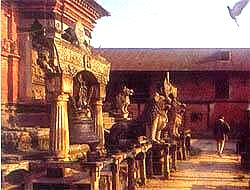 Jagat Narayan Temple, located at Sankhamul, on the banks of the Bagmati, is a tall red brick building with many fine stone and metal statues. The temple is dedicated to Lord Vishnu. Jagat Narayan Temple, located at Sankhamul, on the banks of the Bagmati, is a tall red brick building with many fine stone and metal statues. The temple is dedicated to Lord Vishnu.
-
To the south of Patan lies Godavari Botanical Garden, with hundreds of varieties of flora, dense forest, and open areas, this garden is popular for picnicking, bird watching, hiking, and viewing butterflies.
-
The Patan Zoo, in Jawalakhel, is the only zoo in Nepal. It was established as a private zoo in 1932 and opened to the public in 1956. It houses over 700 different animals, including 14 endangered species of Nepal. There is a pond where visitors can go boating. The zoo is closed on Mondays.
-
The Tibetan Refugee Camp on the outskirts of Patan was set up in 1960 with the aid of the Red Cross and the Swiss Development Corporation to help Tibetan refugees become self-supporting. The camp has carpet factories where tourists are able to view the process for making traditional carpets from start to finish. In addition, handicrafts such as wood and metal prayer wheels are made and sold in souvenier shops.
Where to Stay
Information on where to stay in Patan is coming soon...
Getting There & Away
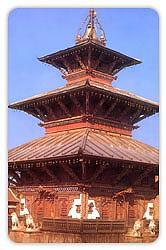 Tourists arrive in the Kathmandu Valley via Tribhuvan International Airport. Airlines flying into this airport include Royal Nepal Airlines, Aeroflot, Biman Bangladesh Airlines, China South-West Airlines, Druk Air, lndian Airlines, Pakistan International Airlines, Singapore Airlines and Thai lnternational. Tourists arrive in the Kathmandu Valley via Tribhuvan International Airport. Airlines flying into this airport include Royal Nepal Airlines, Aeroflot, Biman Bangladesh Airlines, China South-West Airlines, Druk Air, lndian Airlines, Pakistan International Airlines, Singapore Airlines and Thai lnternational.
Patan.com recommends comparing various airlines and ticketing agents with our Travel partner Booking Wiz. (see widget on top right of page)
From the airport, which lies 5.5 km east of Kathmandu, one can take prepaid taxis or buses or rent a car. From Kathmandu, one can take metered taxis or buses from the bus terminal at Gongabu to get to Patan. In addition, metered tempos (scooter taxis), and rickshaws are available. Bicycles and motorcycles can also be rented in Kathmandu.
Getting Around
Patan has buses and taxis, but the distances are short enough for walking. In order to drive a rental car, one needs either an International Driving Permit or a local temporary license. The International Driving Permit is valid in Nepal for 15 days. One can obtain a temporary local license by presenting a valid national license. The minimum driving age in Nepal is 18.
|
|
TRAVEL to Patan!
Use KATHMANDU as your destination city and compare the travel services.
Visit Patan Durbar Square
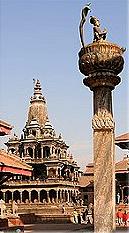
See the ancient palaces, temples, and stone baths and fine stone and bronze art. |
Advertise On Patan.com
Do you own a business in Patan or Nepal? Grow your business by advertising on Patan.com and the rest of the Basecamp International travel network. Contact us today for more information. |
Image Copyright Note
Patan.com is currently seeking royalty free images of the city and surrounding region of Patan, Nepal- and the people living there- for use on our webpages.
If you can provide some of these images, or have any questions regarding an image on this site, please click here to read more about our images & copyright policies. |
|
